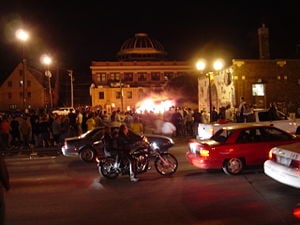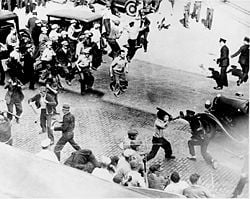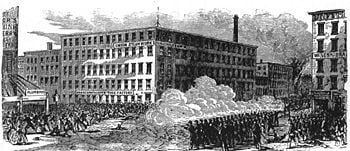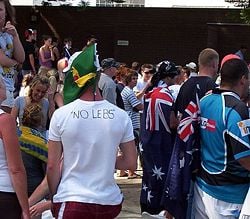Riot
Riots occur when crowds or even small groups of people gather to commit acts of violence and property damage, usually in reaction to a perceived grievance or out of dissent.
Some claim that rioters are motivated by a rejection of or frustration with legal channels through which to air their grievances.
Riots typically involve vandalism and the destruction of private and public property. The specific property to be targeted varies depending on the cause of the riot and the inclinations of those involved. Targets can include shops, cars, restaurants, state-owned institutions, and religious buildings.
Causes of Riots
Historically, riots have occurred for many different reasons. poor working or living conditions, government oppression, taxation or conscription, conflicts between races or religions, or even the outcome of a sporting event. Riots have existed for as long as there have been groups of discontent people. The responses to such discontent varies drastically.
Race Riots
A race riot or racial riot is an outbreak of violent civil unrest in which race is a key factor. The term had entered the English language in the United States by the 1890s. Early use of the term in the United States referred to race riots which were often a dominant culture mob action against individuals or groups of people from other races. Much later, the term came to describe violence and property destruction by racial minority groups often directed at neighborhood business, government representatives and law enforcement agencies perceived as unfairly targeting racial groups. Mob rule, religious animosity, vigilantism, Jim Crow, lynching, racial profiling, economics, police brutality, institutional racism, urban renewal, and racial identity politics are often cited as causes of these riots. However, political decisions, repression and social hate by national or local levels of government and the larger community directed towards a certain race usually contributes to this type of riot.
Prison Riots
A prison riot is a riot that occurs in a prison, usually when those incarcerated rebel openly against correctional officials. It is usually instigated by prisoners who claim that the administration are degrading them, either by direct physical, or psychological force. Riots may also be caused by poor living standards, such as improper plumbing, lack of exercise time, or a lack of educational faculities, or the privilege of attending them. A prison riot can also occur because the criminal element housed inside prisons simply want to be disorderly.
Canadian bank robber and author, Roger Caron chronicled the 1971 Kingston Penitentiary riots in his book Bingo! The Horrifying Eyewitness Account of a Prison Riot which was published in 1985. The book details the release of rage and chaos that ensued after five hundred inmates rioted and destroyed much of the prison.
Student Riots
Student riots, college riots, or campus riots are riots precipitated by students, generally from a college, university, or other school. Those riots often occur after football games, and can be seen as a form of hooliganism; however, sports are not always the cause of such riots. Generally speaking, while college riots were political in nature in the 1960s and the 1970s, riots can also be result of peaceful demonstration oppressed by the authorities. Although sometimes students and alcohol [1] combine to fuel college riots in recent years.
When college students gather together, often they refuse to disperse when police come around and order them to disperse, and the result is, sometimes, the students will clash with the police. Results of student riots tend to include one or more of the following: broken storefront windows, burning furniture, overturned cars, general vandalism of property, injured police or bystanders (occasionally), arrested rioters or bystanders.
Sports Riots

In both the stands and the streets, sports fans may resort to violence to express loyalty to a team, to release frustration with a team’s performance, or to intimidate opponents. Violence may also be related to nationalism or as an outlet for underlying social tensions. It is often alcohol-related. Violence by supporters of sports teams dates back to Roman times, when supporters of chariot racing teams were frequently involved in major riots. A notable example of this is the Nika riots of 532.
The actions of English football hooligans and firms in the 1980s caused English teams to be banned from European competition for six years after the Heysel Stadium disaster in 1985. Although the level of football-related violence was significantly reduced in England after this event, in the recent Euro 2004 tournament, England were publicly warned that any violence by supporters at matches could result in the team's expulsion from the tournament. Many known hooligans were prevented from travelling to the tournament in Portugal. There was a collective sigh of relief from security experts in the USA when England failed to qualify for the 1994 FIFA World Cup. Alan Rothenberg (chairman of the World Cup organising committee in the United States in 1994) said:
- There were three countries in the world whose presence would have created logistical and security problems, so we're very pleased they won't be coming: Iraq, Iran and England.
Police Response
Riots are typically dealt with by the police (as riot control), although methods differ from country to country. Tactics and weapons used can include attack dogs, water cannons, plastic bullets, rubber bullets, pepper spray, and flexible baton rounds. Many police forces, such as the London Metropolitan Police Service, have dedicated divisions to deal with public order situations (see Territorial Support Group, Special Patrol Group, Compagnies Républicaines de Sécurité, Mobiele Eenheid). The policing of riots is controversial due to allegations that officers instigate, provoke or exacerbate situations into full-blown riots (see Police riot); also, while the weapons described above are officially designated as non-lethal, a number of people have died or been injured as a result of their use.
Rioters often make use of various tactics to counter the police, including gas masks (to protect against chemical weapons), projectiles such as rocks, bottles and Molotov cocktails, Firecrackers to scare away K-9 units, and the removal of police weapons (e.g. batons, shields).
Laws against riots
England and Wales
Under English law, a riot is defined by the Public Order Act 1986 as twelve or more persons who "together use or threaten unlawful violence for a common purpose and the conduct of them (taken together) is such as would cause a person of reasonable firmness present at the scene to fear for his personal safety." A single person can be liable for an offence of riot when they use violence provided that it can be shown there were at least twelve present using or threatening violence. The violence can be against the person or against property. This carries the possibility of a fine and a sentence of up to ten years' imprisonment.
If there are fewer than twelve people present, the lesser offence of "Violent Disorder" is charged, for which there is a requirement for at least three persons to use or threaten unlawful violence together. This is defined similarly to riot, but no common purpose is required.
In the past, The Riot Act had to be read by an official - with the wording exactly correct - before any policing action could take place. If the group did not disperse after the act was read, lethal force could legally be used against the crowd.
The Public Order Act 1986 s.1 states:
1) Where twelve or more persons who are present together use or threaten unlawful violence for a common purpose and the conduct of them (taken together) is such as would cause a person of reasonable firmness present at the scene to fear for his personal safety, each of the persons using unlawful violence for the common purpose is guilty of riot.
2) It is immaterial whether or not the twelve or more use or threaten unlawful violence simultaneously.
3) The common purpose may be inferred from conduct.
4) No person of reasonable firmness need actually be, or be likely to be, present at the scene.
5) Riot may be committed in private as well as in public places.[1]
United States
Under United States federal law, a riot is defined as A public disturbance involving (1) an act or acts of violence by one or more persons part of an assemblage of three or more persons, which act or acts shall constitute a clear and present danger of, or shall result in, damage or injury to the property of any other person or to the person of any other individual or (2) a threat or threats of the commission of an act or acts of violence by one or more persons part of an assemblage of three or more persons having, individually or collectively, the ability of immediate execution of such threat or threats, where the performance of the threatened act or acts of violence would constitute a clear and present danger of, or would result in, damage or injury to the property of any other person or to the person of any other individual. 18 U.S.C. §2102.[2]
As every state in the United States has its own laws (subject to the Supremacy Clause), each has its own definition of 'riot.' In New York State, for example, the term 'riot' is not defined explicitly, but under § 240.08 of the N.Y. Penal Law, A person is guilty of inciting to riot when he urges ten or more persons to engage in tumultuous and violent conduct of a kind likely to create public alarm.[3]
Notable riots
United States
The worst riots in United States history with respect to lives lost took place during the Civil War when immigrant factory workers forcibly resisted the federal government's military draft, the New York Draft Riots. These riots were graphically depicted in the movie Gangs of New York. In the 20th century, the 1992 Los Angeles riots were regarded as the worst in recent US history. The 1968 Democratic National Convention, however, saw the most well-remembered riots in recent US history and were a strong influence towards the eventual American withdrawal from Vietnam at the end of the Vietnam War. Also notable were riots in response to the assassination of civil rights leader Martin Luther King, Jr., as well as the recent anarchist and anti-globalization riots of the last decade such as the Seattle protests of the WTO Ministerial Conference of 1999 known as the "Battle of Seattle" and the 2005 Toledo Riot between neo-Nazis and protestors in Toledo, Ohio.[4][5]
Australia
The Sydney Riot of 1879, is one of the earliest riots at an international cricket match. Riots have become major news generators, including Aboriginal riots in response to the death of an Aboriginal boy, and most recently the 2005 summer race riots.[6] These riots took place on the beaches of the eastern Sydney suburbs, most prominently Cronulla.[7]
Asia
The Tiananmen Square protests of 1989 were a series of demonstrations led by students, intellectuals and labour activists in the People's Republic of China between April 15, 1989 and June 4, 1989. The demonstrations centred on Tiananmen Square in Beijing. Government retaliation was often violent and riots broke out in affected regions.
The Jakarta Riots of May 1998 were a series of riots against ethnic Chinese Indonesians in Jakarta and Surakarta, Indonesia.There were also hundreds of documented accounts of ethnic Chinese women being raped, tortured and killed.[8]. Human Rights groups have determined that the Indonesian military was involved in the riots, which degenerated into a pogrom.[9]
The Partition of India was a traumatic event in South Asian history that followed the independence of the region from British colonial rule. The ensuing riots resulted in the deaths of hundreds of thousands of Hindus and Muslims, with Hindus being massacred in the newly formed Pakistan, and Muslims being killed in India.
2002 Gujarat violence refers to incidents that took place in the state of Gujarat in India in the year 2002 involving fatal attacks on the Muslim minority in the state by mobs of Hindus.
In 2006, there were nationwide riots in Pakistan and numerous other areas over the Jyllands-Posten Muhammad cartoons controversy.[10]
Notes
- ↑ Public Order Act 1986 North West Hunt Saboteurs Associatio. Retrieved April 11, 2007.
- ↑ Riots US House of Representatives. April 11, 2007.
- ↑ New York Penal Law. OneCle. Retrieved April 11, 2007.
- ↑ Global protests breed new media BBC News. Retrieved April 11, 2007.
- ↑ Planned neo-Nazi march sparks violence. CNN. Retrieved April 11, 2007.
- ↑ Sydney riots over Aborigine death BBC. Retrieved April 11, 2007.
- ↑ Cars smashed in Cronulla. Sydney Morning Herald. Retrieved April 11, 2007.
- ↑ Indonesia Country Report on Human Rights Practices for 1998 US Department of State. Retrieved April 11, 2007.
- ↑ INDONESIA: Five years after May 1998 rights, those responsible for the atrocities remain at large Asian Human Rights Commission. Retrieved April 11, 2007.
- ↑ Western businesses burn in Pakistan riots Guardian Unlimited. Retrieved April 11, 2007.
ReferencesISBN links support NWE through referral fees
- Blackstones Police Manual Volume 4 General police duties, Fraser Simpson (2006). pp. 245. Oxford University Press. ISBN 0-19-928522-5
- Bessel, Richard Emsley, Clive. Patterns of Provocation: Police and Public Disorder. ISBN 1571812288.
- Hernon, Ian. Riot!: Civil Insurrection from Peterloo to the Present Day. ISBN 0745325386.
- Waddington, P.A.J.. The Strong Arm of the Law: Armed and Public Order Policing. ISBN 0198273592.
Credits
New World Encyclopedia writers and editors rewrote and completed the Wikipedia article in accordance with New World Encyclopedia standards. This article abides by terms of the Creative Commons CC-by-sa 3.0 License (CC-by-sa), which may be used and disseminated with proper attribution. Credit is due under the terms of this license that can reference both the New World Encyclopedia contributors and the selfless volunteer contributors of the Wikimedia Foundation. To cite this article click here for a list of acceptable citing formats.The history of earlier contributions by wikipedians is accessible to researchers here:
The history of this article since it was imported to New World Encyclopedia:
Note: Some restrictions may apply to use of individual images which are separately licensed.


